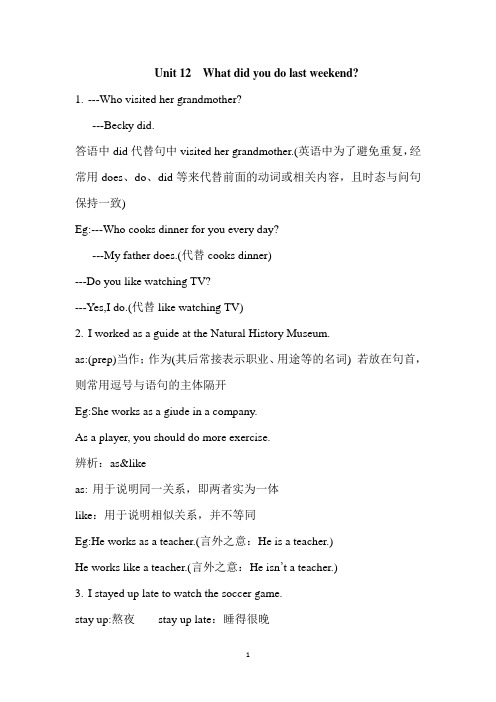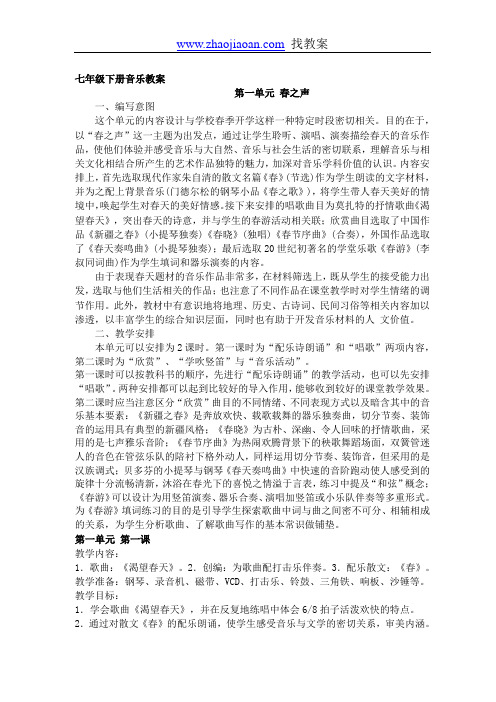人教七年级下册12单元教案
- 格式:doc
- 大小:76.50 KB
- 文档页数:6

七年级下册英语教学计划一、教学基本情况简析1、教材简析七年级下册共12个单元,全书采取任务型语言教学模式,融汇话题、交际功能和语言结构,形成了一套循序渐进的生活化的学习程序。
每个单元都列出明确的语言目标,主要的功能项目与语法结构,需要掌握的基本词汇。
每个单元都分为A、B两部分。
A部分是基本的语言内容,B部分是知识的扩展和综合的语言运用。
每个单元还有self check部分,供学生自我检测本单元所学的语言知识之用。
它采用“语言的输入——学生的消化吸收——学生的语言输出”为主线编排的。
通过确定教学目标,采用听、说、读、写,自我检测等手段,有效提高学习效率,体现了以学生为主体的思想。
不过这套教材是基于城市学生的状况编写的,对于我们农村学生来说,学起来的确有些吃力,光是一千多个单词就吓退了不少学生学习英语的兴趣。
但我们还必须知难而上,为了提高农村的英语教学成绩而努力。
2、学情简析经过一学期的学习,从上期期末成绩来看,我所担任班级学生总体上对英语基础基础知识掌握较差。
只有少数学生学习目的明确,掌握了英语学习的一些基本方法,能够积极主动认真地学习,学习成绩优秀。
而大部分学生对英语感到困难,没有明确的学习目的,缺少学习的热情和主动性,自觉性较差,相应的学习习惯也差。
主要原因是没有激发学生学习英语的兴趣,学生觉得英语学习是一种负担,而不是一种乐趣。
一部分学生没有掌握记忆单词的方法,连基本的单词听写也不过关,导致看不懂,听不懂,学不懂。
学生的听力也还有待提高,在这方面失分也较多。
主要是听的时间太少,接触英语的时间不多。
还有极少部分学生已经放弃学习英语。
二、指导思想根据七年级学生的生理及心理特点和本学期的英语教学目标,我确定了如下的教学指导思想:激发学生学习英语的兴趣,培养他们学习英语的积极态度,使他们建立学习英语的自信心;培养学生的语感和良好的语音、语调基础,使他们形成初步运用英语进行日常交流的能力,为进一步学习打下基础。

Unit 12 What did you do last weekend?1.---Who visited her grandmother?---Becky did.答语中did代替句中visited her grandmother.(英语中为了避免重复,经常用does、do、did等来代替前面的动词或相关内容,且时态与问句保持一致)Eg:---Who cooks dinner for you every day?---My father does.(代替cooks dinner)---Do you like watching TV?---Yes,I do.(代替like watching TV)2.I worked as a guide at the Natural History Museum.as:(prep)当作;作为(其后常接表示职业、用途等的名词) 若放在句首,则常用逗号与语句的主体隔开Eg:She works as a giude in a company.As a player, you should do more exercise.辨析:as&likeas: 用于说明同一关系,即两者实为一体like:用于说明相似关系,并不等同Eg:He works as a teacher.(言外之意:He is a teacher.)He works like a teacher.(言外之意:He isn’t a teacher.)3.I stayed up late to watch the soccer game.stay up:熬夜stay up late:睡得很晚与stay相关的常见短语:stay at home待在家里stay away from远离stay healthy保持健康stay out 待在外面与up相关的短语call up 打电话catch up with 赶上come up with提出get up 起床give up放弃grow up 成长look up 向上看;查出make up编造;构成pick up 捡起;中途载人put up 举起;张贴set up 创建show up出现take up 占据turn up调大use up用完;耗尽4.Father mouse shouted at the cat, “Woof,woof.”辨析:shout at &shout toShout at:冲...大声叫喊(多指因生气/愤怒冲某人叫喊)Eg: He loses his temper and shouts at me.shout to:对...大声叫喊(无恶意,多因距离远)Eg: : “Can you hear me?”he shouts to Tom.5.“Well,son,that’s why it’s important to learn a second language.”(1)that’s why...这就是...的原因why引导的名词性从句在句中作表语Eg:That’s why I can pass the important exam,because I study hard. that’s because...那是因为...(表示原因)Eg:He didn’t go to school trip. That’s because he was badly ill.6.flew a kite 放风筝flew为fly的过去式fly的用法:(vi)(1)fly to乘/坐飞机=go (to)...by plane/airEg:She will fly to New York. She will go to New York by plane/air.(2)飞Eg:He hopes he can fly like a bird.(3)飞逝Eg:How time flies! (时光飞逝)(4)苍蝇Eg:Look! A fly is swimming in the porridge.7.There we put up our tents and made a fire to keep us warm and cook food on.(1)put up:搭建;张贴(动副结构)(2)keep的用法Keep sb./sth.+adj 让某人/某物保持...(强调某种状态)Eg:The coat will keep you warm.The students should keep the classroom clean.Keep sb./sth.+doing 让某人/某物一直...(强调动作的持续性)Eg:I’m sorry I’ve kept you waiting.8.The next morning,my sister and I got a terrible surprise.get a surprise 吃惊(可数名词)surprise:(不可数名词)in surprise惊奇地;惊讶地To one’s surprise 令某人惊讶的是(vt)使吃惊;使惊奇(adj)surprising surprisedEg:Her idea surprises me.9.I was so scared that I couldn’t move.(1)so...that...如此...以致于... (so后接adj/adv)Eg:The box is so heavy that I can’t carry it.He runs so fast that I can’t catch up with him.拓展:such+a/an+adj+单数可数名词+that...相当于so+adj+a/an +单数可数名词+that...Eg:Mr. Yi is such a kind teacher that we all like him. Mr. Yi is so kind a teacher that we all like him.(2)scared:惊慌的;吓坏了的=afraidbe scared of sth. 害怕做某事be scared to do sth.害怕做某事Eg:Miss Zhang is scared/afraid of the ghost.The little boy is scared/afraid to read in fornt of the others.10.感叹句(what/how )。

人教版七年级英语下册unit12优秀教案全文共3篇示例,供读者参考篇1Unit 12 of the People's Education Edition Grade Seven English textbook covers the topic of art and creativity. In this unit, students will learn about different forms of art, discuss their favorite types of art, and participate in various creative activities to express themselves.To make the most of this unit, here is an excellent lesson plan that teachers can follow:Lesson 1: Introduction to ArtObjective: To introduce students to the concept of art and its different forms.Activities:1. Show examples of different types of art such as paintings, sculptures, and music.2. Brainstorm with students about what art means to them and what forms of art they enjoy.3. Discuss the importance of art in society and how it can bea form of self-expression.Lesson 2: Famous ArtistsObjective: To learn about famous artists and their works.Activities:1. Introduce students to well-known artists such as Leonardo da Vinci, Vincent van Gogh, and Pablo Picasso.2. Show pictures of their famous works and discuss the style and themes of their art.3. Have students choose a favorite artist and create a poster about their life and works.Lesson 3: Creating ArtObjective: To engage students in creative activities to express themselves.Activities:1. Provide art supplies such as paints, crayons, and paper for students to use.2. Encourage students to create their own artwork inspired by the styles of famous artists or their own imagination.3. Have a mini art exhibition in the classroom to showcase students' works.Lesson 4: Reflecting on ArtObjective: To reflect on the role of art in our lives and society.Activities:1. Have a class discussion about how art can inspire, entertain, and provoke emotions.2. Ask students to write a reflection on what art means to them and how they can incorporate more art into their lives.3. Watch a short video about the impact of art on society and discuss its importance.By following this lesson plan, teachers can effectively cover the content of Unit 12 and engage students in meaningful discussions and activities related to art and creativity. This will not only help students improve their English skills but also develop their appreciation for art and the creative process.篇2Unit 12 of the People's Education Press seventh grade English textbook is focused on the theme of "Life in the future".In this unit, students will learn how to talk about their future plans, aspirations, and predictions. Here is an excellent lesson plan for teaching Unit 12 of the textbook:Lesson Plan:Title: Life in the futureGrade: 7Unit: 12 (People's Education Press)Theme: Future plans, aspirations, and predictionsDuration: 2 lessons (90 minutes each)Objectives:- Students will be able to talk about their future plans using the simple future tense.- Students will be able to express their aspirations for the future.- Students will be able to make predictions about the future using future tense modal verbs.- Students will be able to write a short paragraph describing their future plans.Warm-up (15 minutes):- Begin the lesson by asking students to brainstorm and discuss what they think life will be like in the future. Encourage them to think about technology, education, careers, and daily life.- Play a short video or show pictures of futuristic inventions and ask students to describe what they see.Presentation (30 minutes):- Introduce the simple future tense to students and explain its formation (will + base verb).- Give examples of how to talk about future plans using the simple future tense.- Practice with students by asking them to talk about their own future plans using the simple future tense.- Introduce future tense modal verbs (will, might, may) for making predictions about the future.- Give examples of how to make predictions using future tense modal verbs.Practice (30 minutes):- Divide students into pairs and ask them to discuss and write down their future plans using the simple future tense.- Monitor and provide assistance as needed.- Ask some pairs to share their plans with the class.Production (15 minutes):- Ask students to write a short paragraph (5-7 sentences) describing their future plans using the simple future tense.- Provide a writing prompt to help guide students in their writing.- Allow students to share their paragraphs with the class.Review and Assessment (15 minutes):- Review key concepts and vocabulary from the lesson.- Ask students to complete a short quiz or worksheet to assess their understanding of the simple future tense and future tense modal verbs.- Provide feedback and address any misconceptions.Homework:- Assign students to write a diary entry about a day in their future life using the simple future tense.By following this lesson plan, students will be able to effectively communicate their future plans, aspirations, andpredictions in English. This lesson plan incorporates various activities to engage students and reinforce key language concepts related to the theme of "Life in the future" in Unit 12 of the People's Education Press seventh grade English textbook.篇3Unit 12: You’re supposed to shake handsTeaching Objectives:1. Students will be able to understand the cultural differences in greetings between different countries.2. Students will be able to use the target language for greetings appropriately.3. Students will be able to reflect on the importance of cultural understanding and respect.Teaching Procedures:Step 1: Warm-up (10 minutes)- Begin the class by showing a video clip of people from different cultures greeting each other. Ask the students to share their thoughts on the various greetings they saw.- Discuss the importance of greetings in different cultures and how they can vary from country to country.Step 2: Presentation (15 minutes)- Introduce the target language for greetings and practice pronunciation with the students.- Show a slideshow or video presentation of common greetings in different countries, emphasizing the cultural significance of each greeting.- Have students take notes on the different greetings and their cultural meanings.Step 3: Practice (20 minutes)- Divide the class into pairs or small groups and have them practice the target language greetings with each other.- Encourage students to think about the appropriate greetings for different situations (formal vs. informal, meeting strangers vs. meeting friends).- Monitor and provide feedback as needed.Step 4: Cultural Understanding (15 minutes)- Engage the students in a discussion about the importance of cultural understanding and respect when greeting others.- Ask students to reflect on a time when they may have misunderstood a greeting in a different culture and how they could have handled the situation better.- Encourage students to think about ways they can show respect for other cultures in their daily lives.Step 5: Review and Assessment (10 minutes)- Review the target language greetings with the whole class and assess student understanding through a quick quiz or game.- Encourage students to continue practicing their greetings outside of the classroom and to explore more about different cultures and their greetings.Homework:- Ask students to research a different culture and its traditional greetings, and to write a short reflection on what they learned.By following this detailed lesson plan, students will not only learn the target language for greetings but also gain a deeperunderstanding of the importance of cultural awareness and respect.。

人教版英语七年级下册教案主备人:_ _ 审核人:复备人:1. 熟记并运用本单元重点单词和短语及句型。
2. 学会灵活运用wh-引导的一般过去时态的特殊疑问句句型。
3. 能够运用本单元重点单词和句型写一篇关于周末活动的文章。
一般过去时态的特殊疑问句句型。
一般过去时态的特殊疑问句句型。
默写下列短语1 深夜不睡;熬夜__________ 2去看电影___________3 去划船________4 在湖边野营________5 去海滩__________6 打羽毛球__________7 备考数学测验____________ 8 在星期六上午________9 以...的身份工作_________ 10 生活习惯__________11 跑开_____________ 12 冲...大声叫嚷_________13 爬到....上面___________14 弄丢东西_________15 上个周末____________16看望她的祖母_______17 和....一起去___________18 老鼠一家________19 弹吉它_____________20 去图书馆________21 和朋友吃晚饭_________22 放风筝________23 待在家里________24 玩得开心________25 待在家里____________ 26 中学__________27 搭起,举起___________28 互相;彼此______29 吃惊_________ 30 上上下下,起伏______31 把...弄醒___________32 对....大声喊叫_______五、讲授新课,师精讲,生精练。
(10分钟)1. shout at ... 冲...大声叫嚷区别:shout at与shout to: shout at:近距离喊叫,带有训斥之意。
shout to:远距离喊叫,告知提醒某人。
eg:Don't shout at me. 别冲我大喊大叫。

Unit11-12复习Unit11重点短语:go for a walk 去散步milk a cow 挤牛奶ride a horse 骑马feed chickens 喂鸡talk with 和……交谈take photos 拍照show…around 带领……参观in the countryside 在农村go fishing 去钓鱼go to the zoo 去动物园climb the mountains 爬山visit a museum 参观博物馆fire station 消防站draw picture 画画science museum 科学博物馆by train 乘火车in all 一共;总共be interested in 对……感兴趣not…at all 一点也不quite a lot 相当多learn about 了解grow strawberries 种植草莓pick strawberries 采草莓from..to…从……到……at night 在夜晚come out 出来along the way 沿线 a lot of 许多;大量buy sth. for sb. = buy sb. sth.为某人买某物go on a shool trip 去学校郊游after that 之后all in all 总的来说重点句子:1.Did you see any cows?你看见奶牛了吗?Yes,I did.I saw quite a lot.是的,我看见了许多。
2.Did you ride a horse?你骑马了吗?No,I didn’t.But I milked a cow.不,我没有,但我挤牛奶了。
3.How was your school trip?你的学校旅游怎么样?4.What did Tina do?蒂娜干什么了?She picked some strawberries.她摘了一些草莓。

七年级下册音乐教案第一单元春之声一、编写意图这个单元的内容设计与学校春季开学这样一种特定时段密切相关。
目的在于,以“春之声”这一主题为出发点,通过让学生聆听、演唱、演奏描绘春天的音乐作品,使他们体验并感受音乐与大自然、音乐与社会生活的密切联系,理解音乐与相关文化相结合所产生的艺术作品独特的魅力,加深对音乐学科价值的认识。
内容安排上,首先选取现代作家朱自清的散文名篇《春》(节选)作为学生朗读的文字材料,并为之配上背景音乐(门德尔松的钢琴小品《春之歌》),将学生带人春天美好的情境中,唤起学生对春天的美好情感。
接下来安排的唱歌曲目为莫扎特的抒情歌曲《渴望春天》,突出春天的诗意,并与学生的春游活动相关联;欣赏曲目选取了中国作品《新疆之春》(小提琴独奏)《春晓》(独唱)《春节序曲》(合奏),外国作品选取了《春天奏鸣曲》(小提琴独奏);最后选取20世纪初著名的学堂乐歌《春游》(李叔同词曲)作为学生填词和器乐演奏的内容。
由于表现春天题材的音乐作品非常多,在材料筛选上,既从学生的接受能力出发,选取与他们生活相关的作品;也注意了不同作品在课堂教学时对学生情绪的调节作用。
此外,教材中有意识地将地理、历史、古诗词、民间习俗等相关内容加以渗透,以丰富学生的综合知识层面,同时也有助于开发音乐材料的人文价值。
二、教学安排本单元可以安排为2课时。
第一课时为“配乐诗朗诵”和“唱歌”两项内容,第二课时为“欣赏”、“学吹竖笛”与“音乐活动”。
第一课时可以按教科书的顺序,先进行“配乐诗朗诵”的教学活动,也可以先安排“唱歌”。
两种安排都可以起到比较好的导入作用,能够收到较好的课堂教学效果。
第二课时应当注意区分“欣赏”曲目的不同情绪、不同表现方式以及暗含其中的音乐基本要素:《新疆之春》是奔放欢快、载歌载舞的器乐独奏曲,切分节奏、装饰音的运用具有典型的新疆风格;《春晓》为古朴、深幽、令人回味的抒情歌曲,采用的是七声雅乐音阶;《春节序曲》为热闹欢腾背景下的秧歌舞蹈场面,双簧管迷人的音色在管弦乐队的陪衬下格外动人,同样运用切分节奏、装饰音,但采用的是汉族调式;贝多芬的小提琴与钢琴《春天奏鸣曲》中快速的音阶跑动使人感受到的旋律十分流畅清新,沐浴在春光下的喜悦之情溢于言表,练习中提及“和弦”概念;《春游》可以设计为用竖笛演奏、器乐合奏、演唱加竖笛或小乐队伴奏等多重形式。
Unit 12 Section B(2a-2c)教案【教学目标】1. 学生根据图片和文章标题等||,预测新课内容||。
2. 学生能通过不同的阅读策略||,整体感知文章结构(总分)、搜寻主题句、关键词捕捉文章信息||。
3. 通过完成一系列问题掌握文章的写作手法、写作顺序、写作结构||,熟练掌握目标语言结构:Last weekend was...but...; so...that…; see...doing...; feel...doing...和大量的动词短语||。
4. 通过了解蛇和印度文化||,拓宽视野||。
【教学重难点】●重点:熟练掌握文章中出现的所有动词短语||,熟练掌握动词过去式的写法||。
能借助不同的方式复述故事||。
●难点:通过读故事提炼出文章的结构(总分)、顺序(时间顺序)、内容(六要素:how||,what||,who||,when||,where||,why||。
【课前准备】课本、多媒体课件、学案||。
【教学方法】头脑风暴、情景交际法、predicting||,skimming||,scanning||,careful reading||,detailed understanding||,catching and filling in the key words||,putting in the right order||,retelling等阅读策略、观察与思考、构建图式、文化渗透等||。
【新课导入】Step l: Lead-inBrainstorming: Can you list as many adjectives of describing animals as possible||,【新知呈现】Step 2: Presentation (2a)1. Brainstorming: Can you list animals we have learned? What kinds of animals are you sometimes afraid of? (Put a for being afraid of) Why?Animals Be afraid of Why2. Work in groups. Exchange your ideas with your group members.3. Ask several students to share their ideas in front of whole class.(设计意图:通过brainstorming复习动物词汇||,通过询问学生What kinds of animals are you sometimes afraid of? Why? 引出交际的内容||,激活与文章有关的背景知识||,鼓励学生发表个人看法||,在最短的时间里融入英语课堂||。
新人教版七年级数学下册全册教案附同步练习及单元测试卷(含答案)第五章相交线与平行线5.1.1相交线教学目标:1.理解对顶角和邻补角的概念,能在图形中辨认.2.掌握对顶角相等的性质和它的推证过程.3.通过在图形中辨认对顶角和邻补角,培养学生的识图能力.重点:在较复杂的图形中准确辨认对顶角和邻补角.难点:在较复杂的图形中准确辨认对顶角和邻补角.教学过程一、创设情境,引入课题先请同学观察本章的章前图,然后引导学生观察,并回答问题.学生活动:口答哪些道路是交错的,哪些道路是平行的.教师导入:图中的道路是有宽度的,是有限长的,而且也不是完全直的,当我们把它们看成直线时,这些直线有些是相交线,有些是平行线.相交线、平行线都有许多重要性质,并且在生产和生活中有广泛应用.所以研究这些问题对今后的工作和学习都是有用的,也将为后面的学习做些准备.我们先研究直线相交的问题,引入本节课题.二、探究新知,讲授新课1.对顶角和邻补角的概念学生活动:观察上图,同桌讨论,教师统一学生观点并板书.【板书】∠1与∠3是直线AB、CD相交得到的,它们有一个公共顶点O,没有公共边,像这样的两个角叫做对顶角.学生活动:让学生找一找上图中还有没有对顶角,如果有,是哪两个角?学生口答:∠2和∠4再也是对顶角.紧扣对顶角定义强调以下两点:(1)辨认对顶角的要领:一看是不是两条直线相交所成的角,对顶角与相交线是唇齿相依,哪里有相交直线,哪里就有对顶角,反过来,哪里有对顶角,哪里就有相交线;二看是不是有公共顶点;三看是不是没有公共边.符合这三个条件时,才能确定这两个角是对顶角,只具备一个或两个条件都不行.(2)对顶角是成对存在的,它们互为对顶角,如∠1是∠3的对顶角,同时,∠3是∠1的对顶角,也常说∠1和∠3是对顶角.2.对顶角的性质提出问题:我们在图形中能准确地辨认对顶角,那么对顶角有什么性质呢?学生活动:学生以小组为单位展开讨论,选代表发言,井口答为什么.【板书】∵∠1与∠2互补,∠3与∠2互补(邻补角定义),∴∠l=∠3(同角的补角相等).注意:∠l与∠2互补不是给出的已知条件,而是分析图形得到的;所以括号内不填已知,而填邻补角定义.或写成:∵∠1=180°-∠2,∠3=180°-∠2(邻补角定义),∴∠1=∠3(等量代换).学生活动:例题比较简单,教师不做任何提示,让学生在练习本上独立完成解题过程,请一个学生板演。
人教版初中英语七年级下册十一单元讲义教案UNIT11第一部分【重点短语】给奶牛挤奶去钓鱼骑马喂鸡go for a walk show sb. aroundquite a lot/quite a lot of+n.learn a lot about sth. grow strawberriespick strawberries pick uptake sth. home in the countrysideworry+that从句worry about ……/be worried about ……last week come outIt was so much fun. have so much fun.an art museum the science museumgo on a trip along the waymake a model robot buy sth. for sb.= buy sb. sth.all in all it’s difficult (for sb.) to do sth.not at all be interested in (doing)sth.【答案】从左至右:milk a cow; go fishing; ride a horse; feed chickens; 去散步=take a walk;带领某人参观;相当多的;关于…学到很多;种草莓;摘草莓;捡起/接某人;带…回家; 在农村;担心……; 担心某人某事;上周;出来/出版/开花;如此有趣;玩得非常开心;一个艺术博物馆;科学博物馆;去旅行;沿途;制作一个机器人模型;为某人买某物;总之;对某人来说做某事很困难;根本不/一点也不;对(做)…感兴趣第二部分【重点语法】一、一般过去时1.定义一般过去时表示过去某个时间或一段时间内发生的动作或状态;也可表示过去经常或反复发生的动作。
e.g.I got up at 7:00 yesterday. 我昨天7点起床。